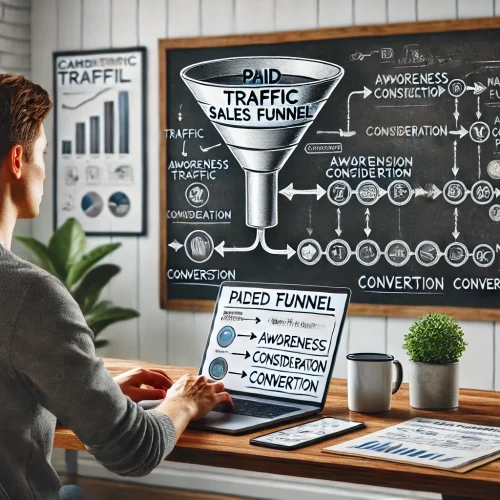Affiliate marketing has become one of the most accessible and scalable ways to make money online — and it continues to grow in popularity around the world. Whether you’re a complete beginner or have some experience online, understanding how affiliate marketing works is a powerful first step toward building digital income.
In this article, we’ll break down what affiliate marketing is, how it actually works behind the scenes, and how you can start using it to earn money online — even if you have no product of your own.
What Is Affiliate Marketing?
Affiliate marketing is a performance-based marketing strategy where a person (called an affiliate) promotes a product or service created by someone else. When a purchase is made through the affiliate’s unique link, they earn a commission.
It’s essentially a digital version of recommending a product to a friend — but when that recommendation turns into a sale, you get paid.
How Does It Work?
Let’s break it down step-by-step:
1. You Join an Affiliate Program
An affiliate program is run by a company or platform that sells products or services. When you join, you get a unique tracking link (affiliate link) to promote their offerings.
Popular affiliate networks:
- Amazon Associates
- ClickBank
- Hotmart
- ShareASale
- CJ Affiliate
- PartnerStack (for software/SaaS)
2. You Choose Products to Promote
You can select products that match your audience’s interests or your content niche. For example:
- A fitness blog might promote supplements or workout gear
- A tech YouTube channel could promote laptops or editing software
- A digital marketing blog could promote email tools or online courses
3. You Promote the Products Online
You can share your affiliate links in many places:
- Blog posts
- YouTube videos
- Email newsletters
- Pinterest pins
- Social media (with proper disclosure)
Your goal is to drive people to click your link and make a purchase.
4. You Earn a Commission for Each Sale
When someone clicks your affiliate link and buys, the sale is tracked through cookies or unique IDs. You get paid a percentage of that sale — this can range from 3% to 70% or even higher, depending on the product and platform.
Real-Life Example
Imagine you have a blog about productivity. You write a post titled “Top 5 Tools I Use to Stay Focused Working From Home” and include an affiliate link to a time-tracking software.
- A reader clicks your link
- They sign up for a paid plan
- You earn a commission — let’s say $20
- If the software pays monthly, you might even earn recurring commissions
Types of Affiliate Programs
There are a few common types of affiliate commission structures:
1. Pay-Per-Sale
This is the most common. You earn a fixed amount or a percentage each time someone makes a purchase through your link.
2. Pay-Per-Lead
You get paid when someone signs up or completes a specific action — like creating an account or filling out a form (often used in finance or insurance niches).
3. Recurring Commissions
Some software companies offer ongoing commissions as long as your referred customer keeps paying (monthly or yearly).
Why Affiliate Marketing Is So Popular
- ✅ No need to create your own product
- ✅ Low startup cost
- ✅ You can work from anywhere
- ✅ Unlimited income potential
- ✅ Scalable through content creation
It’s especially ideal for bloggers, YouTubers, email marketers, social media creators, and even those just getting started online.
Where Can You Promote Affiliate Links?
Here are some of the most effective platforms:
Blogging
Write helpful articles, how-to guides, product comparisons, and tutorials.
YouTube
Create review videos, unboxings, or demos showing the product in action.
Instagram or TikTok
Use stories, short videos, or link in bio tools to drive traffic.
Create visual pins that link to blog posts or direct affiliate pages.
Email Marketing
Build a list and share valuable recommendations through regular newsletters.
Rules and Best Practices
Affiliate marketing works best when done ethically and transparently. Always:
- Disclose that you’re using affiliate links (“I may earn a commission if you buy through my link”)
- Only promote products you trust or have researched
- Focus on helping your audience, not just making sales
- Create genuine, useful content — don’t just spam links
Many countries (like the U.S. and EU) require affiliate disclosure by law.
How to Get Started in 5 Simple Steps
- Pick a niche you’re interested in (fitness, tech, travel, productivity, etc.)
- Choose a platform to build your content (blog, YouTube, Instagram, etc.)
- Join affiliate programs related to your niche
- Create helpful content that includes your affiliate links
- Track results and optimize based on performance
Mistakes to Avoid
- ❌ Promoting too many products at once
- ❌ Not disclosing your affiliate relationship
- ❌ Choosing products only for the commission (and not for the audience)
- ❌ Spamming links instead of creating valuable content
- ❌ Giving up too soon — affiliate marketing takes time to grow
How Much Can You Earn?
Earnings vary widely depending on traffic, niche, and how well your content converts.
- Beginners might earn $100 to $500/month
- Intermediate creators often make $1,000 to $5,000/month
- Top affiliates earn six or even seven figures per year
Consistency and audience trust are key.
Final Thoughts: Affiliate Marketing Is a Long-Term Game
Affiliate marketing isn’t a get-rich-quick scheme — it’s a real business model. If you’re committed to creating value and learning how to connect people with the right solutions, you can build a sustainable income stream over time.
Start small. Focus on one platform. Choose quality products. And keep learning.








